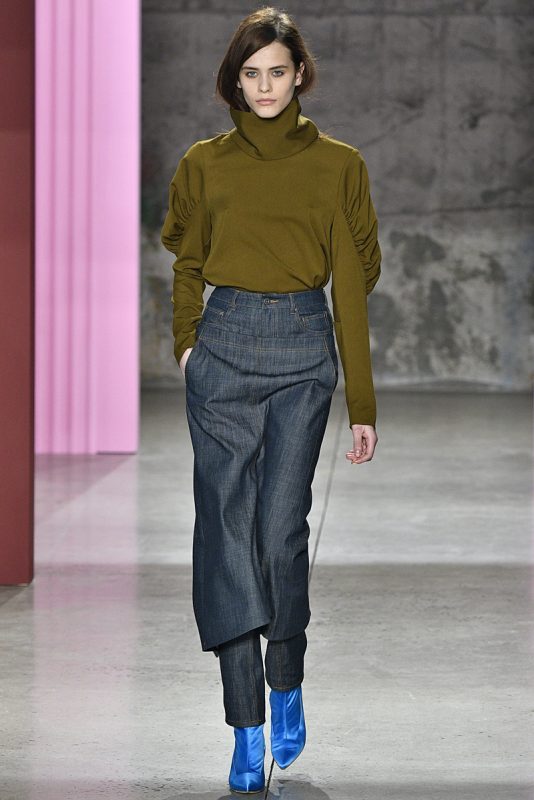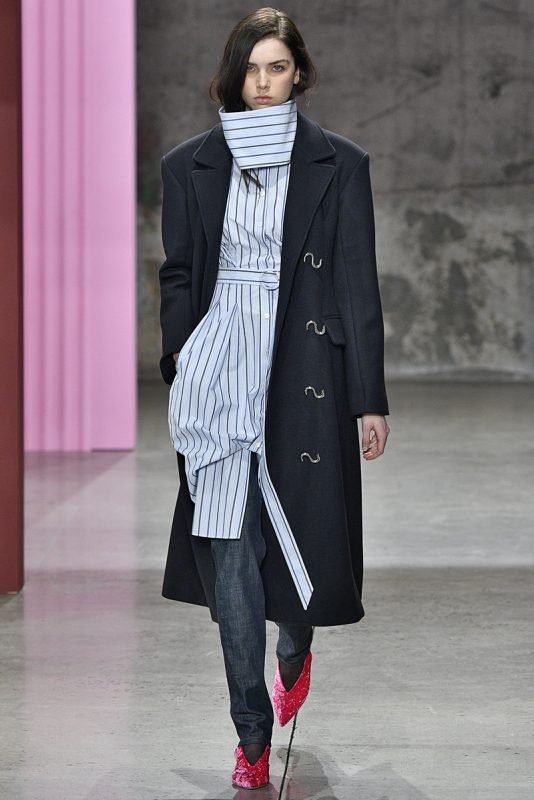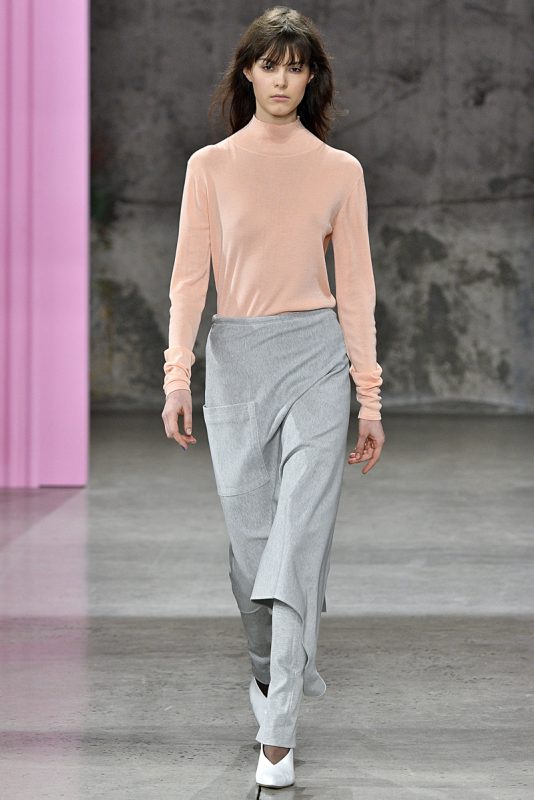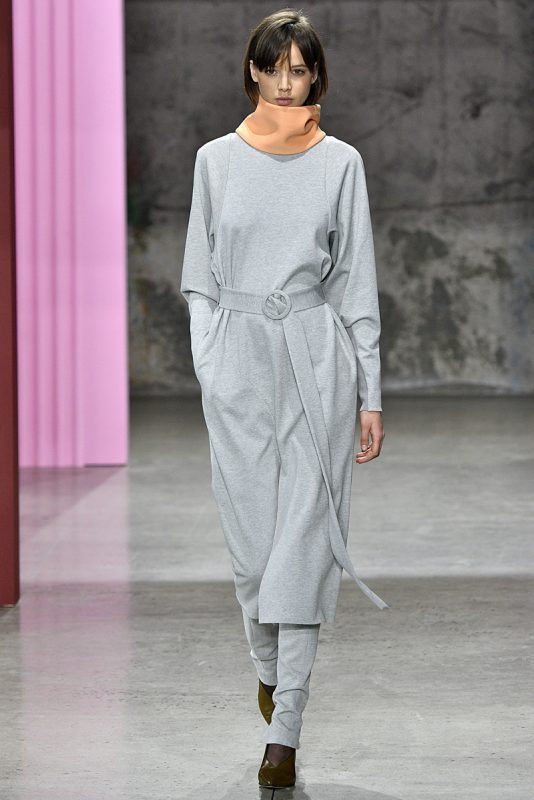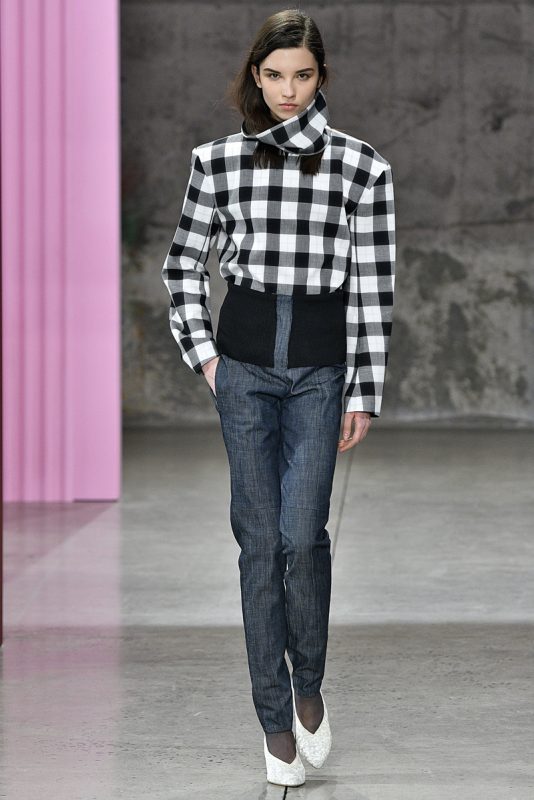In the fashion business, there’s nothing more elusive than longevity, but Tibi’s Amy Smilovic has achieved exactly that. As she celebrates the brand’s 20th anniversary, Smilovic looks back on its salad days as a three-employee enterprise in Hong Kong—and reveals her vision for its future.
- Tibi New York Womenswear FW17 New York February 2017
- Tibi New York Womenswear FW17 New York February 2017
- Tibi New York Womenswear FW17 New York February 2017
Before you launched the brand, you were working in advertising at Amex. How did that happen?
My husband and I were both working there. He was transferred to Hong Kong, and I would have been reporting to him, so that was not going to happen! [Laughs] The move was a really exciting chance to do something on my own.
How long did it take you to start your business after arriving in Asia?
Three days. I’m not exaggerating. It was so fast, in fact, that John Stossel, who was at 20/20 at the time, did a story on barriers to starting and running businesses in different countries, comparing America, India, Paris, and Hong Kong, and I was their profile for Hong Kong to illustrate how fast an entrepreneur can set up business there.
Hong Kong is known for its production capabilities. How was that useful to you?
It was a huge advantage, and I wish I had known how much of an advantage it was at the time. In 1997, it was something like 30 percent of all clothing in America was made in China and now it’s almost 90 percent. When I launched, I had department stores say, “What if I asked you for 800 units in two weeks? Could you do that?” And I would say, “Of course! My factory would be so happy.”
Without a design background, how did you know where to begin?
Due to my background in advertising, I worked with many entrepreneurs, so I knew what was critical to starting a business. I knew that you made a product and then you had to sell that product for significantly more than what it cost to make, and that you use that margin to cover your expense base. But when I arrived in Hong Kong, I called a headhunting agency to find a factory. I wanted them to be able to speak English and be very patient with someone who doesn’t know what they’re doing. They came back to me with these two young Chinese guys, Benny and Ivan, and they were totally entrepreneurial in spirit. The idea of working with a brand that wasn’t an Ann Taylor or a Walmart was really exciting to them.
What happened next?
I went to their office with these crappy little sketches and I thought we were going to have this big meeting and that we would memo each other and confirm and debate pricing. I walked in and they saw my drawings and they just said, “$10.” That was what it cost to make the sample. By Day 3, I had a sample line. On Day 5, I went to the American Women’s Association and I met a 23-year-old woman named Octavia [Hyland]. She was like, “What are you doing today?” And I said, “Oh, I started a company two days ago and I’m going to visit my sample maker.” She ended up coming with me, and we were talking about how there was no easy cotton clothing to wear in Hong Kong. We wanted to do something that had more Western fits. I figured I might as well start another company, so we designed two dresses, some pants, and a skirt, and we gave them to Benny and Ivan.
What was your first big hurdle?
We needed more boutique fabrics, so I called the Indonesian Consulate looking for factories on the island of Java, where all the printers were. We stayed at the Shangri-La in the middle of Jakarta, and we set up appointments with six printing mills. We were there in short shorts and T-shirts waiting for these mills to come, and no one showed up. Finally, by 6 p.m. this man and a woman in a burka walked in. She had been expecting two Chinese men from Hong Kong and was surprised that we were American women in shorts and T-shirts. Their printing factory was an hour away, so they invited us to come stay in one of their huts. And we went with these total strangers. Can you imagine? They put us in a little house on top of all these rice patties. We chose four different prints from their Ikat screens, and we designed some prints as well. But when the prints were delivered they were in five-yard rolls and some of them had chicken scratches, because they had been laid out in the fields to dry. We ordered 400 of each of the styles and stored the finished clothes in the kitchen cabinets and bathtubs at our house in Hong Kong.
How did you start selling all the clothing?
We trolled the expat bars looking for clients. There was a big Dutch and Australian community, and they couldn’t fit into anything made in Hong Kong, so we zoomed in on them. We had a party in my apartment, and we sold $12,000 worth of clothing. We took the remaining samples to the U.S. to show them to stores.
Who in the U.S. was the first to see Tibi?
Ann Watson at Neiman Marcus. She ended up picking up the line, and we got 13 other accounts. I went back to Hong Kong and shipped our first shipment—4,000 pieces of clothing—to my parents’ house in St. Simons Island, Georgia, in a container truck.
What did your parents think?
[Laughs] My mom was actually the assistant vice president at the local high school at the time, and at work she kept getting all these calls from Neiman Marcus and Saks Fifth Avenue. My old principal from high school was doing the accounting and teachers would do the packing on the weekend. Eventually we got proper employees.
How did you end up landing Saks Fifth Avenue?
Sarah Rutson was at Lane Crawford and had picked us up after reading an article in the South China Morning Post—we had worked the PR angle right away. She told me that I should really be at the Coterie trade show. At Coterie, we picked up Saks right away because we had product ready to ship.
What was your biggest learning curve?
Saks eventually called wanting to return. They called my mom at the high school with an RA. That’s when Octavia was like, “Oh, this isn’t so fun anymore.” Then it was just me with the company.
What happened?
I sent out one shipment of dresses that had these cone boobs, like the Gaultier Madonna cone boobs, only it was not Gaultier and not Madonna. All the stores called wanting to return them. I remember crying so hard. I had to eat $20,000 worth of clothing at the time. My husband said to me, “You have to take the return. In the end it’s going to be about customer service, and hopefully in the future this will just be a blip on the screen and you can laugh about it.” And it was. [Laughs]
How did you recover?
Eventually we hired Linda Underwood, who was based out of New Orleans and went on the road to sell the collection. She was really the reason we were able to launch. She was all about relationships, so I had someone really finessing that. I didn’t even know to go to a showroom. In hindsight, it was great, because any of these showrooms would have dumped me right away. I could choose to manage these mishaps in a way that was good for me. That was critical.
What do you consider your first big hit?
I was designing my own prints and working with beautiful silks in China. Jeannine Braden from Fred Segal walked by our booth at Coterie and wanted to buy all the skirts, but she wanted them in five different prints. I had rented an apartment on MacDougal Street, where there was a vintage store selling old scarves in a bin. There was something so gross and tacky about them, and I felt that if they were executed on really luxurious silk, it could be cool. I did about seven prints on the skirts, and my friend from Paris was like, “That’s so vulgar.” But that was kind of what I was going for. Bill Cunningham did a whole page on them.
You eventually reinvented your brand entirely.
By 2000, I had been back in New York and we were a full-on contemporary brand. We ended up getting very locked into prints. Around 2006 or 2007, people started to get hyper-focused. Stores were saying, “Oh, I don’t want sweaters from you anymore because if it’s cashmere we go to Autumn Cashmere,” and “I don’t want a T-shirt from you because I go to Velvet Tees.” Everyone started getting siloed, and I had to do printed dresses every season. It became such a slog because I had to design in a category that wasn’t really on-trend anymore. I wasn’t loving what I was doing. So I decided to do something more authentic.
What did you learn from that process?
By 2010, brands were more visible to women in every country because of social media. I found that if you create something authentic, your woman will find you. You don’t have to be something to everyone, you just have to be something incredibly meaningful to someone. We have a huge following in the Middle East, London, Stockholm, Japan, and Russia. I had buyers telling me that if I wanted to be in the Middle East it had to have a diamond on it, or if I wanted to be in Japan, it had to have a cat on it. And they’re so wrong. Designers, do not listen to them! Your customer has a reason for coming to you.
What was one of your aesthetic turning points?
We did a collection for Spring 2012 that didn’t have one print in it. We thought we would let the fallout happen with Resort, because we felt like we could weather that storm a little better. All our core items today were in that collection. Then we brought in Elin Kling to help us style the next spring collection, so we could generate some buzz. We really haven’t looked back.
Did you lose a lot of retailers?
Tons, and rightly so. We were no longer right for some of them. But producing something real is so critical. It’s so critical to own your staples, but once they become an albatross around your neck, you have to cut them loose.
What’s the plan for the next 20 years?
The business will look totally different from today. I think we will have even more meaningful partnerships with fewer companies. I know that men’s will be in our future, but I don’t know when. I think handbags will be a larger part of our line. We will be much more global in scope.
PLUS! Five Thing You Never Knew About Amy Smilovic:
1) I love stale Peeps, and gross candy in general
2) I’m good at whiffling.
3) I was voted “most humorous” in my high school class.
4) I painted the side of our house yellow when I was 8. My parents were unaware.
5) I had my first real job at age 10, and I haven’t stopped working since.
- Tibi New York Womenswear FW17 New York February 2017
- Tibi New York Womenswear FW17 New York February 2017
- Tibi New York Womenswear FW17 New York February 2017
- Tibi New York Womenswear FW17 New York February 2017
- Tibi New York Womenswear FW17 New York February 2017
- Tibi New York Womenswear FW17 New York February 2017
- Tibi New York Womenswear FW17 New York February 2017
- Tibi New York Womenswear FW17 New York February 2017
- Tibi New York Womenswear FW17 New York February 2017
- Tibi New York Womenswear FW17 New York February 2017
- Tibi New York Womenswear FW17 New York February 2017
- Tibi New York Womenswear FW17 New York February 2017
- Tibi New York Womenswear FW17 New York February 2017
- Tibi New York Womenswear FW17 New York February 2017
- Tibi New York Womenswear FW17 New York February 2017
- Tibi New York Womenswear FW17 New York February 2017
- Tibi New York Womenswear FW17 New York February 2017
- Tibi New York Womenswear FW17 New York February 2017
- Tibi New York Womenswear FW17 New York February 2017
- Tibi New York Womenswear FW17 New York February 2017
- Tibi New York Womenswear FW17 New York February 2017
- Tibi New York Womenswear FW17 New York February 2017
- Tibi New York Womenswear FW17 New York February 2017
- Tibi New York Womenswear FW17 New York February 2017
- Tibi New York Womenswear FW17 New York February 2017
- Tibi New York Womenswear FW17 New York February 2017
- Tibi New York Womenswear FW17 New York February 2017
- Tibi New York Womenswear FW17 New York February 2017
- Tibi New York Womenswear FW17 New York February 2017
- Tibi New York Womenswear FW17 New York February 2017
- Tibi New York Womenswear FW17 New York February 2017













